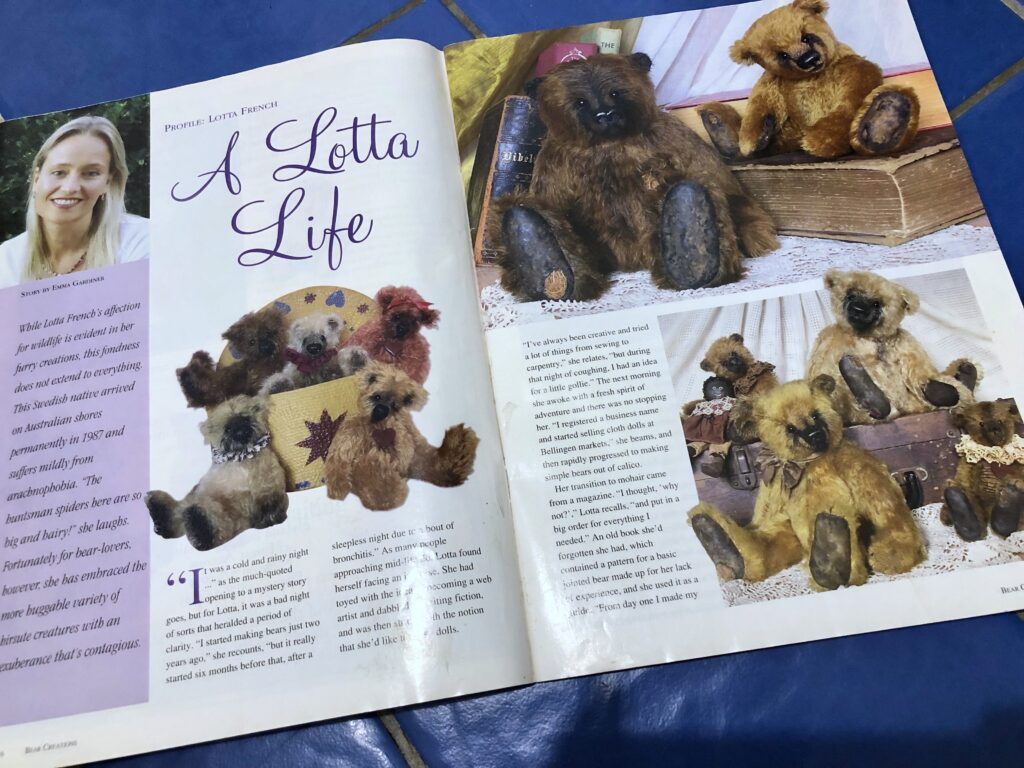Agnes & Me - part 3
Agnes is an introvert who spends hours and hours in the attic of her house where she designs and sews teddy bears that she then sells online. I’m not an introvert and in our attic you can’t stand up straight and there are no floorboards only joists, but I spent eight years of my life doing exactly what Agnes does. I sold my bears on eBay and I attended teddy bear shows—lots in Australia, one in New York, and one in Stratford-up-on-Avon in the glorious Cotswolds UK.
In Agnes & Me – part 2, you can read about how my bear story started. After our first show, I had to go home and figure out how to make noses all myself.
Side note: Wayne had great success selling resin noses to bear artists as well as wholesalers in Australia, the States, and Europe.
But I was determined to create noses I could be proud of. After hours of experimentation, this became my solution: I would draw the shape over the finished muzzle, embroider layer upon layer until I had a 3D nose, and then finish by painting on melted black wax that I would polish after it hardened. I, who’d dreaded making noses, came to enjoy that part of the process and even to find it meditative. In the end, the most dreaded task turned out to be fastening the ears. I would save that for last. Often I had over a dozen bears, all finished with their ears hanging on with only pins. I’d be madly sewing them on during the last night and into the early hours the day I’d leave for whatever show I was going to.



Apart from local shows, I went to Melbourne, Sydney, Brisbane, and my favourite, Jupiter’s Casino on the Gold Coast. I, who’d only ever won a bronze medal in the year seven high jump, won plenty of awards for my work. A brown bear, I’d posted to the South Australian show in Adelaide, won Bear of the Show. A highlight for me was Brisbane where I won Bear of the Show and sold every single bear I’d brought with me.
In America, I also sold out. Or rather my youngest daughter did while her mum the bear artist—knocked sideways by jetlag—slept under the table the entire weekend. The few times she pulled herself to a standing position, the artist’s slurred English sounded as if she’d overdosed on Valium. This is what I imagine because I have precious little memory from that weekend. This is all in reference to daytime. The night hours I endured wide awake counting sheep while my daughter slept deeply.



At the US show, international artists could accept card payments using the host’s terminal, who would then pay the artist in cash. This was a great help, but the problem was, by the end of the show I’d sold too many bears and they had trouble finding enough cash to reimburse me. Late in the evening, I was called to one of the hotel rooms. A small crowd waited in there. The organisers had scraped together—from each other, friends, and family—the funds needed and laid it all out on a bed for me to count. There were about six thousand US dollars in 1, 2, and 5 dollar notes and a heap of coins. I travelled back to Manhattan with a heavy handbag.

I began my bear journey in 2001. On my website, I stated, ‘I’ve finally found what I want to do when I grow up.
So why did it end?
In 2009 a rep from Abercrombie & Fitch in the US contacted me. A friend of hers had one of my koalas in her collection. A & B were opening new stores and koalas would fit the theme. They wanted one hundred of them. I explained that what I made were collectables, not toys, not suitable for children, handmade and therefore not cheap. This woman was adamant. They wanted my koalas.
The company sent over a 50-page contract that asked questions like how many buildings were on the premises, whether water was made available to the workers, and how many toilet breaks were allowed … You get the picture. Once I persuaded them to a two-page contract, I had to order special warning sew-in-tags and accept that there was no affordable insurance to cover me. In case a child pulled out a koala eye and ate it, to keep my family from financial ruin, I would have to divorce my husband, disappear from all Australian records, and go live on a remote island under a new name.
The small koala I made and sold at shows for $120 AU was the one this woman had seen. That koala contained 13 body parts. That meant 1300 body parts would need to be drawn on the back of the material, cut out, and then trimmed 5m around all edges so fur wouldn’t catch when I sewed the seams. These parts would need to be stitched, turned right side out, and stuffed. The koalas had moveable limbs and necks so 500 joints would need to be assembled and connected. They would also need eyes sewn in and noses done. These koalas wouldn’t get my first-class noses. Instead, I’d sculpt them using polymer clay and once baked, I’d attach them with glue and stitches. Oh, mama!
We settled for $80 US / each. I can’t remember what the dollar was at the time, but it was a fair price.


My mum came to visit that summer and couldn’t believe the thirteen craters that lined up the hallway. I bought myself an electric cutter and got to work. Instead of making one koala from beginning to end, I treated it as factory work. I calculated the time for each koala to be 3.5 hours and that made my hourly rate acceptable. My Husqvarna would sew all hundred left legs in one hit, then the right and so forth. In my 80-square-foot spare room, I had my very own sweatshop. To keep the American Union happy, I could drink as much water and take as many toilet breaks as I wanted.
Once a bear is stuffed and jointed, you must of course close the small open holes on their head, limbs and body. Five holes to ladder-stitch per koala. Let’s just say, my mum and I had plenty of time to chat. Several weeks later and summer gone, I jam-packed the koalas in a box and had a courier pick them up so I knew they would reach their destination. I got paid which put a great big smile on my face.

But something had shifted in me. I’d lost interest in sewing another bear as long as I lived. Before the Abercrombie & Fitch order, I’d made many hundreds of koalas and kangaroos (I used to sell them at the Opera House market in Sydney which is another story for another time). And then there was my pride and joy, my high-end artist bears—each a unique character with his or her own name. When naming the bears, I’d name the first bear something beginning with the letter A. The next bear would have a name that began with B etc. I’d gone from A to Z seven or eight times, and I was done with the alphabet, and I was done with the stuffing that is truly hard work especially when you use so called woodwool (wood shavings) which I usually did, for the vintage feel. I was done for.
So I packed up my sewing room.



I still have lots of fur, all the tools (though some have rusted), all the discs, screws, and nuts. It’s now been packed away for 14 years. Now and then I think I should try to sell the materials online. Maybe this year I will. I have a few scattered bears left, some kangaroos, and a few wombats and koalas. I could have sold them when I was still a name in the artist bear industry, but I walked away exhausted.
I don’t know what the moral of this story is. I had fun for so long. So much fun. It didn’t make me rich, though it helped a little to our household’s budget with small victories along the way, and I was able to work from home. More than that, I met beautiful people. Teddy bear artists and collectors are a special kind of delightful.

I gave Agnes this art and craft. When I first made her a teddy bear artist, it was to honour something from my past and also because it’s a job I know so well. Funny how writing a story takes on a life of its own. As it turned out, my protagonist’s odd career and obsession with teddy bears became pivotal to the story. I won’t tell you why. You’ll need to read Agnes Treading Water for that.

